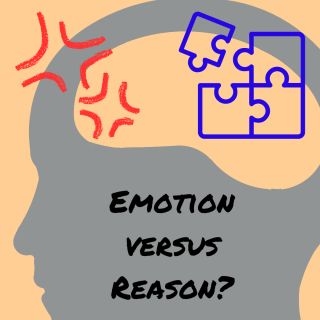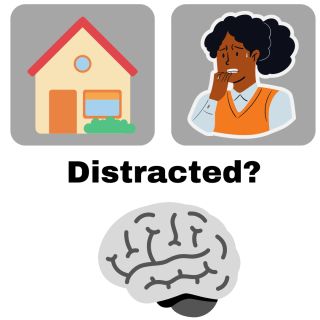Emotions
Thinking Versus Feeling in the Brain
Modern theories address an ancient debate about reason versus emotion.
Posted July 17, 2023 Reviewed by Kaja Perina
Key points
- Philosophers and psychologists have long argued that reason and emotion are two separate, opposing systems.
- In the late 1990's, Antonio Damasio's research group found that emotion can improve decision-making.
- In 2013, researcher Luiz Pessoa published a book examining how emotion and reason interact in the brain.
- He explains that emotions grab attention and "cognitive resources," which can help or hinder different tasks.

One of the deepest themes in psychology and philosophy is the conflict between reason and emotion. It is seen in works from Plato’s analogy of the human mind as a chariot, with reason being the charioteer trying to reign in horses representing passions, to modern dual process theories of the mind like the one presented in psychologist Daniel Kahneman’s Thinking, Fast and Slow, to neuroscientist Joseph LeDoux’s work on a “low road” for emotional processing and a “high road” for deeper processing of information in the brain.
The core idea is that reason and logic are good, reliable ways of getting to an accurate understanding of the world around us. Emotion, on the other hand, is irrational and leads us to act too quickly and make mistakes in our thinking.
This core dichotomy between emotion and reason was what originally drew me to graduate school in psychology. I believed that most people expected others to behave much more rationally than they really did, and that if we wanted to get a more accurate understanding of what motivated behavior we needed to look past their stated, “logical” reasons for action and to their emotional experiences. One of the key theories that drove my interest in this area was Antonio Damasio’s Somatic Marker Hypothesis. The short version of the theory is that human emotional systems are actually needed to make good decisions. Emotional responses—which can be seen in the body through things like increased sympathetic responses (e.g., changes in heart rate, sweat on the palm or fingertips)—motivate us to make a particular decision, which ultimately allows us to stop analyzing and just choose.
Further, the body can sometimes encode information that we don’t even consciously understand. In a classic set of experiments, Damasio and his colleagues found that when people were playing a gambling game, they started having physiological responses to choices from risky decks of cards before they could consciously articulate why they were making certain decisions. People with damage to emotional parts of the brain didn’t get these early emotional responses to risky choices, and they also were worse at picking up on which decks were a risky—and poor—play. This is a case where emotional responses seemed to help lead people to make better choices. Later follow-up work found that people who had a better ability to notice their own bodily sensations (a skill called “interoception”) were better able to use their emotions to learn about the gambling game.
Recently, I picked up a book that I got during graduate school but never finished, called The Cognitive-Emotional Brain by Luiz Pessoa. Pessoa is a well-known neuroscientist whose work explores the interplay of reason and emotion in the brain. Reading through this work—now a decade old—is reigniting my interest in this interplay between thinking and feeling. I hope to pull several lessons I can present in blog form from this (highly technical) work.
The first, brief point I would make about the book concerns the idea of a “push-pull” model of emotion and reason. Pessoa is looking for ways to understand how reason (or what modern researchers would refer to as executive function or cognitive control) is changed by emotion. To that end, he reviews several studies (including some he conducted) on difficult reasoning and memory tasks that were performed with or without emotional information. For example, one experiment might have you remember an image of a house while being distracted by other images of buildings, while another might have you remember a neutral face while being distracted by images of scared faces. These studies are perfectly set up to create the kinds of conflicts philosophers and scientists have talked about for generations: emotion versus reason.

Some of these studies find that emotional information is more distracting than other types of information. For example, if you’re trying to memorize something and a scared face pops up on-screen, your brain seems to have to do more work to keep it in mind.
But there are other studies that suggest that emotional information can actually facilitate performance. When you’re trying to remember a scared face from among many other faces, the emotional nature of the face can actually make it easier to remember. Overall, the pattern suggests that emotional information is better at capturing our attention than other kinds of information. Seeing that a person is scared of something feels more important, at a basic level, than seeing one familiar building among many others.
Pessoa argues that different aspects of careful reasoning–what psychologists would call executive control—are recruited by emotion. For example, we might think of careful reasoning involving skills like updating information, shifting attention, and stopping (or inhibiting) a first response. Skills like this, Pessoa argues, are part of a common pool of thinking resources. So our “updating information” skill can only be used up to a limited amount at any one time. When we see emotional information, it grabs our attention—and some of our limited bandwidth for reasoning. We automatically feel like we need to process that emotional information, even if it’s just there as a distraction we need to ignore. This can pull our cognitive resources away from the careful thinking we are meant to be doing.
Reading this account of neuroscience research on reason and emotion, what becomes clear is that emotion is special, important—and not always bad. What really matters is the context. What are we trying to accomplish? If we’re meant to be just memorizing complex information without caring about the emotional content, then yes—emotions are distracting and make it harder to keep the information in mind. But in other tasks, emotion can be an important signal. When the information we’re trying to memorize naturally has emotional content, then our tendency to pay special attention to emotion actually helps us. For example, in Damasio’s gambling experiments, paying attention to emotional information helped people play better. Gambling is, of course, a realm where emotions are highly activated.
Ultimately, Pessoa’s view of thinking and feeling (cognition and emotion) is one that tries to understand how they are integrated in the brain. If we think back to Plato’s rational charioteer trying to steer the horses of passion, we might update the analogy slightly. Sometimes we need to steer the horses away from danger—but sometimes the horses alert us to something our rational minds missed.


